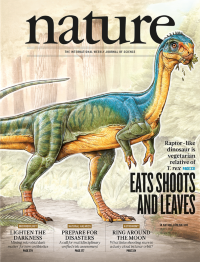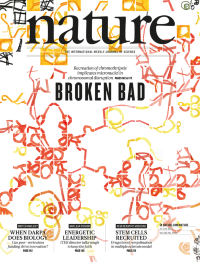Volume 522
-
No. 7557 25 June 2015
An adapted image showing condensed mitotic chromosomes (blue); co-localization between telomeric TTAGGG repeats (green) and a DNA damage marker (red) indicates that telomeres are recognized as damage in cells that spontaneously arrest in mitosis during crisis. Cells forming a tumour must overcome two barriers before becoming cancerous. The first is senescence and the second is a proliferative block known as crisis. Cells that escape senescence usually succumb during crisis, but it has not been clear what triggers cell death at that stage. Jan Karlseder and colleagues now demonstrate that cells that bypass senescence in the absence of p53 have shortened telomeres that undergo fusion, and these fusions trigger mitotic delay. During mitotic arrest telomeres are further deprotected and detected by the DNA damage machinery, which leads to cell death. These findings might offer a clinical opportunity, as exacerbation of mitotic telomere deprotection sensitizes cancer cells to mitotic drugs � but mitotic arrest has also been associated with genome instability and tumorigenesis in checkpoint-compromised cells. (Cover illustration by Jamie Simon, The Salk Institute)
Nature Outlook
-
No. 7556 18 June 2015
Chilesaurus diegosuarezi, seen in a reconstruction by Gabriel Lio eating plant foliage in an extinct Patagonian forest. This newly discovered dinosaur species from the Aysén fossil locality in southern Chile has been characterized as a primitive theropod from the Late Jurassic (about 150 million years ago). Theropods, a group that includes Tyrannosaurus and Velociraptor, were generally bipedal and apart from some later highly derived forms, were almost always carnivores. The new species is a relatively early offshoot in theropod evolution but was a herbivore, combining an unprecedented combination of characters and a bizarre anatomy not recorded before among dinosaurs. The discovery illustrates how little we still know about even the broad strokes of dinosaur evolution. Cover: Gabriel Lio
Insight
-
No. 7555 11 June 2015
Dis-assembly�, Daniel Kohns interpretation of a chromothripsis event from his series Thinking about Science � DataSets�. Chromothripsis, a dramatic chromosomal event involving massive chromosome breakage and rearrangement, typically restricted to one or a few of a cells chromosomes, has been observed in various cancers and congenital diseases. A new study uses a combination of live-cell imaging and single-cell genome sequencing to recreate chromothripsis-like rearrangements. The results show that after single chromosomes are missegregated into so-called micronuclei, they can shatter. After cell division, these fragments can be incorporated back into the genome, generating rearrangements that in some cases bear all the hallmark features of chromothripsis. Chromosome shattering in micronuclei can also lead to the formation of small circular chromosome fragments, the initial step in forming double minute chromosomes�, which carry amplified oncogenes in cancer. This study thus provides the first experimental demonstration of a molecular mechanism underlying chromothripsis. Cover art by Daniel Kohn, http://www.kohnworkshop.com/
-
No. 7554 4 June 2015
An illustration of the mechanism at work behind the scenes in the Pluto system: 'gear ratios' are such that the observed orbital ratios of 1:3:4:5:6 are enforced. With NASAs New Horizons probe fast approaching Pluto for its flyby on 14 July, Mark Showalter and Douglas Hamilton present new results from the Pluto system and offer some predictions about what the spacecraft might observe. Plutos four small moons � Styx, Nix, Kerberos and Hydra follow near-circular, near-equatorial orbits around the central binary planet� comprising Pluto and its large moon, Charon. In an analysis of Hubble Space Telescope images, Showalter and Hamilton demonstrate that Styx, Nix and Hydra are tied together by a three-body resonance. Perturbations by the other bodies inject chaos into this otherwise stable configuration so that Nix and Hydra rotate chaotically, driven by the large torques of the PlutoCharon binary. Nix and Hydra have bright surfaces similar to that of Charon. Kerberos may be much darker. Cover art: Mark A. Garlick/markgarlick.com.




